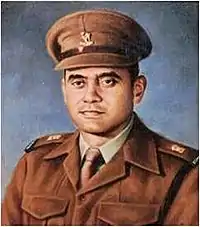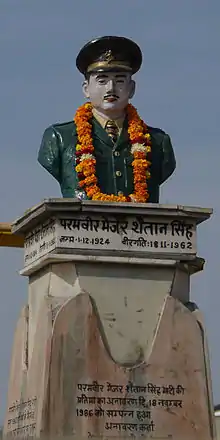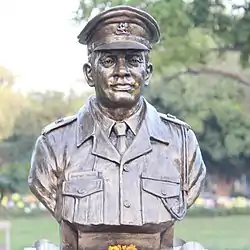Shaitan Singh
Major Shaitan Singh Bhati, PVC (1 December 1924 – 18 November 1962) was an Indian Army officer and recipient of the Param Vir Chakra, India's highest military decoration. Singh was born in Rajasthan. On completing his graduation, Singh joined the Jodhpur State Forces. He was transferred to the Kumaon Regiment after the princely state of Jodhpur was merged into India. He took part in operations in the Naga Hills and also in the 1961 Indian annexation of Goa.
Shaitan Singh Bhati | |
|---|---|
 Portrait of Shaitan Singh | |
| Born | 1 December 1924 Jodhpur State, British India |
| Died | 18 November 1962 (aged 37) Rezang La, Union Territory of Ladakh |
| Allegiance | |
| Service/ | |
| Years of service | 1949–1962 |
| Rank | |
| Service number | IC-6400[1] |
| Unit | 13 KUMAON |
| Battles/wars | Ethnic conflict in Nagaland 1961 Indian annexation of Goa Sino-Indian War |
| Awards | |
| Spouse(s) | Shagun Kanwar[2] |
During the 1962 Sino-Indian War, 13th Battalion of Kumaon Regiment was stationed in the Chushul sector. C Company, under the command of Singh, was holding a position at Rezang La. In the morning hours of 18 November 1962, the Chinese attacked. After several unsuccessful attacks from the front, the Chinese attacked from the rear. The Indians fought until their last rounds, before eventually being overpowered by the Chinese. During the battle, Singh continuously moved from post to post reorganizing the defences and boosting the morale of his men. As he moved between the posts without any cover, he was seriously wounded, and later succumbed to his injuries. For his actions on 18 November 1962, Singh was awarded the Param Vir Chakra.
Early life
Shaitan Singh was born on 1 December 1924 in a Bhati Rajput family of Banasar village, Jodhpur district, Rajasthan.[1] His father was Lieutenant Colonel Hem Singh. Lt. Col. Singh served in France with the Indian Army during World War I, and was awarded the Order of the British Empire (OBE) by the British government.[3]
Singh studied in the Chopasni Senior Secondary School, Jodhpur up to his matriculation. At school, he was known for his skills as a football player. After completing his schooling in 1943, Singh went to Jaswant College, and completed his graduation in 1947. On 1 August 1949,[3] he joined the Jodhpur State Forces as an officer.[4]
Military career
After the princely state of Jodhpur was merged into India, Singh was transferred to the Kumaon Regiment. He was promoted to captain on 25 November 1955,[5] and took part in operations in Naga Hills and also in 1961 Indian annexation of Goa. On 11 June 1962, he was promoted to the rank of major.[4]
1962 Sino-Indian War
There had long been disagreement between India and China over borders in the Himalaya region. To counter the increasing Chinese intrusions into disputed territory, then Prime Minister of India Jawaharlal Nehru asked for strategies for dealing with them. However, the proposal put forward by the Indian Army was rejected. Instead, he approved a plan proposed by a bureaucrat called the "Forward Policy". This called for the establishment of a number of small posts facing the Chinese. Due to the severe rise in public criticism against Chinese intrusions, Nehru implemented the "Forward Policy" against the advice of the army.[6] The army's concern was that the Chinese had geographical advantage. Additionally, maintaining numerous small posts would be untenable if the Chinese superior forces attacked. This was ruled out by Nehru who believed the Chinese would not attack. But the Chinese did, initiating the Sino-Indian War.[7]
Battle of Rezang La

During the war, the 13th Battalion of Kumaon Regiment was positioned in Chusul sector. At a height of 5,000 metres (16,000 ft) above sea level,[8] the C Company under the command of Singh was holding a position at Rezang La, and the area was defended by five platoon posts. In the morning hours of 18 November 1962, the Chinese attacked. Indians prepared for an offensive as they saw the Chinese advancing through nullahs[lower-alpha 1] in the dim dawn lighting. At 5:00 am, as platoons got a better sight of the Chinese, they started firing with light machine guns, rifles, mortar, and grenades, killing many Chinese soldiers.[1]
At 5:40 am, the Indians were fired upon by artillery and mortar. Again, around three hundred and fifty Chinese soldiers started to advance through nullahs. No. 9 Platoon held fire until the Chinese were as close as 90 metres (300 ft), and inflicted heavy casualties.[1] As attacks from the vanguard were unsuccessful, around four hundred Chinese troops attacked from the rear. Simultaneously, No. 8 Platoon was fired upon with medium machine guns from the wire fencing of the post, and also received artillery and mortar fire. No. 7 Platoon was attacked by one hundred and twenty Chinese soldiers from the rear. The Indians countered with 3-inch (76 mm) mortar shells and killed many Chinese soldiers. As the last twenty survivors charged towards the post, the Indians jumped out of their trenches and engaged in hand-to-hand combat with the Chinese soldiers. However, the Platoon was soon encircled with the arrival of Chinese reinforcements. Eventually, No. 7 & 8 platoons were left with no survivors.[9]
During the battle, Singh continuously moved from post to post reorganizing the defenses and boosting the morale of his men. As he moved between the posts without any cover, he was seriously wounded. While he was being evacuated by his soldiers, the Chinese started to fire heavily on them. Sensing the danger, Singh ordered the soldiers to leave. They placed him behind a boulder, where he succumbed to his injuries. In the battle, the Indian side suffered 114 casualties out of 123.[lower-alpha 2] Singh's body was found at the same boulder. It was brought to Jodhpur and cremated with military honors.[9]
Param Vir Chakra
For his actions at the Battle of Rezang La, on 18 November 1962, Singh was awarded the Param Vir Chakra. The official citation read:
Major Shaitan Singh was commanding a company of an Ahir infantry battalion deployed at Rezang La in the Chusul sector at a height of about 16,000 feet. The locality was isolated from the main defended sector and consisted of five platoon-defended position. On 18 November 1962, the Chinese forces subjected the company position to heavy artillery, mortar and small arms fire and attacked it in overwhelming strength in several successive waves. Against heavy odds, our troops beat back successive waves of enemy attack. During the action, Major Shaitan Singh dominated the scene of operations and moved at great personal risk from one platoon post to another sustaining the morale of his hard-pressed platoon posts. While doing so he was seriously wounded but continued to encourage and lead his men, who, following his brave example fought gallantly and inflicted heavy casualties on the enemy. For every man lost to us, the enemy lost four or five. When Major Shaitan Singh fell disabled by wounds in his arms and abdomen, his men tried to evacuate him but they came under heavy machine-gun fire. Major Shaitan Singh then ordered his men to leave him to his fate in order to save their lives. Major Shaitan Singh's supreme courage, leadership and exemplary devotion to duty inspired his company to fight almost to the last man.
Other honours

In 1980s, the Shipping Corporation of India (SCI), a Government of India enterprise under the aegis of the Ministry of Shipping, named fifteen of its crude oil tankers in honour of the PVC recipients. The tanker MT Major Shaitan Singh, PVC was delivered to SCI in 1985, and served for 25 years before being phased out.[11][12]
Notes
Footnotes
- A nullah or a nulla (Urdu: نلہ or "nallah" in Punjabi) is an 'arm of the sea', stream, or watercourse, a steep narrow valley.
- According to the report by Indiatimes, the Indian troops suffered 114 casualties out of a 120-man force.[10]
Citations
- Chakravorty 1995, p. 73.
- "Major Shaitan Singh's widow dies". Business Standard. Press Trust of India. 18 April 2015. Retrieved 4 December 2017.
- Reddy 2007, p. 41.
- Reddy 2007, p. 42.
- "Part I-Section 4: Ministry of Defence (Army Branch)". The Gazette of India. 9 June 1956. p. 113.
- Cardozo 2003, p. 73.
- Cardozo 2003, p. 74.
- "Param Vir Chakra Winners Since 1950". The Times of India. Bennett, Coleman & Co. Ltd. 25 January 2008. Archived from the original on 15 November 2017. Retrieved 4 December 2017.
- Chakravorty 1995, p. 74.
- Maninder Dabas (18 November 2016). "55 Years Ago, 120 Men Saved Ladakh From China. This Is The Story Of The Greatest Last Stand Ever At Rezang La!". Indiatimes. Retrieved 4 December 2017.
- "IMO: 8316613". Marine Traffic. Retrieved 4 December 2017.
- Raj & Shanmugam 2009, p. 179.
References
- Chakravorty, B.C. (1995), Stories of Heroism: PVC & MVC Winners, New Delhi: Allied Publishers, ISBN 978-81-70235-16-3
- Raj, Anthony S.; Shanmugam, Sudalaimuthu S. (2009), Logistics Management for International Business: Text and Cases, PHI Learning, ISBN 978-81-20337-92-3
- Reddy, Kittu (2007), Bravest of the Brave: Heroes of the Indian Army, New Delhi: Prabhat Prakashan, ISBN 978-81-87100-00-3
- Cardozo, Major General Ian (retd.) (2003), Param Vir: Our Heroes in Battle, New Delhi: Roli Books, ISBN 978-81-74362-62-9
Further reading
- Rawat, Rachna Bisht (2014), The Brave: Param Vir Chakra Stories, Penguin Books India Private Limited, ISBN 978-01-4342-235-8

